-
Countries
-
Data and Analysis
-
Special Focus
-
Crisis Responses
Displacement Report
Country
Title Standard
Mozambique — Displacement Report {#} ({DATE})
Contact
DTM Mozambique, DTMMozambique@iom.int
Type
Component
Domain
Confidential
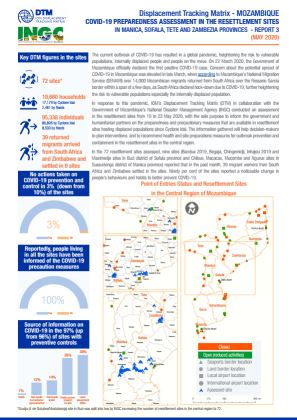
Contact
DTMMozambique@iom.int
Language
English
Location
Mozambique
Period Covered
May 19 2020
May 23 2020
Activity
- Mobility Tracking
- Site Assessment
In response to this pandemic, IOM’s Displacement Tracking Matrix (DTM) in collaboration with the Government of Mozambique’s National Disaster Management Agency (INGC) conducted an assessment in the resettlement sites from 19 to 23 May 2020, with the sole purpose to inform the government and humanitarian partners on the preparedness and precautionary measures that are available in resettlement sites hosting displaced populations since Cyclone Idai. The information gathered will help decision-makers to plan interventions and restrictions and to recommend health and site preparations measures for outbreak prevention and containment in the resettlement sites in the central region.
In the 72 resettlement sites assessed, nine sites (Bandua 2019, Begaja, Chingemidji, Inhajou 2019 and Maximedje sites in Buzi district of Sofala province and Chibue, Macocoe, Mucombe and Ngurue sites in Sussudenga district of Manica province) reported that in the past month, 39 migrant workers from South Africa and Zimbabwe settled in the sites. Ninety per cent of the sites reported a noticeable change in people’s behaviours and habits to better prevent COVID-19.
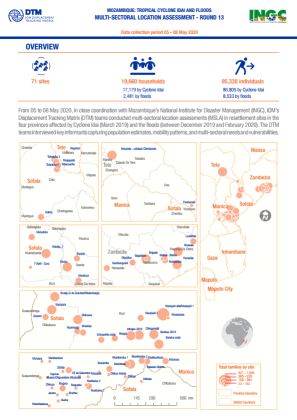
Contact
DTM Mozambique, DTMMozambique@iom.int
Language
English
Location
Mozambique
Period Covered
May 05 2020
May 08 2020
Activity
- Mobility Tracking
From 05 to 08 May 2020, in close coordination with Mozambique’s National Institute for Disaster Management (INGC), IOM’s Displacement Tracking Matrix (DTM) teams conducted multi-sectoral location assessments (MSLA) in resettlement sites in the four provinces affected by Cyclone Idai (March 2019) and the floods (between December 2019 - February 2020). The DTM teams interviewed key informants capturing population estimates, mobility patterns, and multi-sectoral needs and vulnerabilities

Contact
DTM Mozambique, DTMMozambique@iom.int
Language
English
Location
Mozambique
Period Covered
Feb 27 2020
Feb 28 2020
Activity
- Mobility Tracking
On the night of 27 to 28 April 2019, Tropical Cyclone Kenneth made landfall in northern Mozambique. The cyclone brought torrential rains and winds affecting mostly the provinces of Cabo Delgado, Nampula and Pemba, causing flash flooding and subsequent destruction.
From 27 to 28 February, in close coordination with Mozambique’s National Institute for Disaster Management (INGC), IOM DTM (Displacement Tracking Matrix) teams conducted baseline assessments at locality level (localidade), which corresponds to the lowest administrative level in the country. The third round covered 12 districts in Cabo Delgado and Nampula provinces. The DTM teams interviewed locality chiefs capturing population estimates and geographic distribution, population movements, shelter repairs and access to services in host communities.
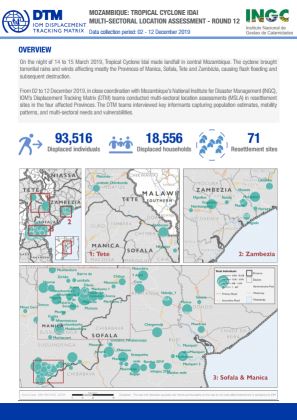
Contact
DTM Mozambique, DTMMozambique@iom.int
Language
English
Location
Mozambique
Period Covered
Dec 02 2019
Dec 12 2019
Activity
- Mobility Tracking
From 02 to 12 December 2019, in close coordination with Mozambique’s National Institute for Disaster Management (INGC), IOM’s DTM teams conducted multi-sectoral location assessments (MSLA) in resettlement sites in the four affected Provinces of Sofala, Manica, Tete and Zambezia.
The DTM teams interviewed key informants capturing population estimates, mobility patterns, and multi-sectoral needs and vulnerabilities.
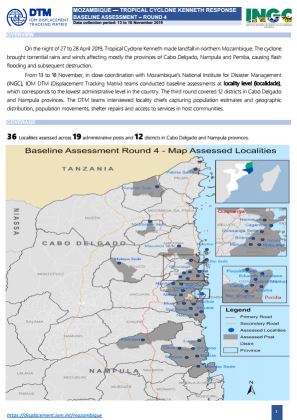
Contact
DTM Mozambique, DTMMozambique@iom.int
Language
English
Location
Mozambique
Period Covered
Nov 13 2019
Nov 18 2019
Activity
- Mobility Tracking
- Baseline Assessment
On the night of 27 to 28 April 2019, Tropical Cyclone Kenneth made landfall in northern Mozambique. The cyclone brought torrential rains and winds affecting mostly the provinces of Cabo Delgado, Nampula and Pemba, causing flash flooding and subsequent destruction. From 13 to 18 November, in close coordination with Mozambique’s National Institute for Disaster Management (INGC), IOM DTM (Displacement Tracking Matrix) teams conducted baseline assessments at locality level (localidade), which corresponds to the lowest administrative level in the country. The third round covered 12 districts in Cabo Delgado and Nampula provinces. The DTM teams interviewed locality chiefs capturing population estimates and geographic distribution, population movements, shelter repairs and access to services in host communities.
The dataset can be accessed at the following link: https://displacement.iom.int/datasets/mozambique-%E2%80%94-baseline-assessment-cyclone-kenneth-response-%E2%80%94-round-4
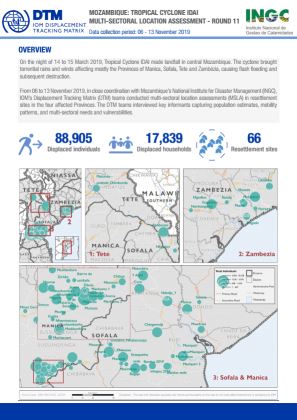
Contact
DTM Mozambique, DTMMozambique@iom.int
Language
English
Location
Mozambique
Period Covered
Nov 06 2019
Nov 13 2019
Activity
- Mobility Tracking
- Site Assessment
From 06 to 13 November 2019, in close coordination with Mozambique’s National Institute for Disaster Management (INGC), IOM’s Displacement Tracking Matrix (DTM) teams conducted multi-sectoral location assessments (MSLA) in resettlement sites in the four affected Provinces. The DTM teams interviewed key informants capturing population estimates, mobility patterns, and multi-sectoral needs and vulnerabilities
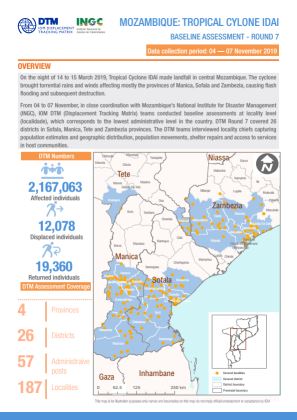
Contact
DTM Mozambique, DTMMozambique@iom.int
Language
English
Location
Mozambique
Period Covered
Nov 04 2019
Nov 07 2019
Activity
- Mobility Tracking
- Baseline Assessment
From 04 to 07 October, in close coordination with Mozambique’s National Institute for Disaster Management (INGC), IOM DTM (Displacement Tracking Matrix) teams conducted baseline assessments at locality level (localidade), which corresponds to the lowest administrative level in the country. DTM Round 7 covered 26 districts in Sofala, Manica, Tete and Zambezia provinces. The DTM teams interviewed locality chiefs capturing population estimates and geographic distribution, population movements, shelter repairs and access to services in host communities.

Contact
DTM Mozambique, DTMMozambique@iom.int
Language
English
Location
Mozambique
Period Covered
Oct 02 2019
Oct 09 2019
Activity
- Mobility Tracking
From 02 to 06 October, in close coordination with Mozambique’s National Institute for Disaster Management (INGC), IOM DTM (Displacement Tracking Matrix) teams conducted baseline assessments at locality level (localidade), which corresponds to the lowest administrative level in the country. The second round covered 26 districts in Sofala, Manica, Tete and Zambezia provinces. The DTM teams interviewed locality chiefs capturing population estimates and geographic distribution, population movements, shelter repairs and access to services in host communities.
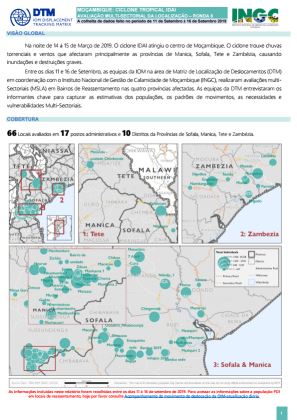
Contact
DTM Mozambique, DTMMozambique@iom.int
Language
Portuguese
Location
Mozambique
Period Covered
Sep 11 2019
Sep 16 2019
Activity
- Mobility Tracking
- Site Assessment
Entre os dias 11 e 16 de Setembro, as equipas da IOM na área de Matriz de Localização de Deslocamentos (DTM) em coordenação com o Instituto Nacional de Gestão de Calamidade de Moçambique (INGC), realizaram avaliações multi-Sectoriais (MSLA) em Bairros de Reassentamento nas quatro províncias afectadas. As equipas da DTM entrevistaram os informantes chave para capturar as estimativas dos populações, os padrões de movimentos, as necessidades e vulnerabilidades Multi-Sectoriais.
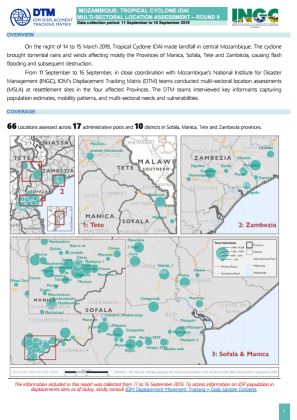
Contact
DTM Mozambique, DTMMozambique@iom.int
Language
English
Location
Mozambique
Period Covered
Sep 11 2019
Sep 16 2019
Activity
- Mobility Tracking
- Site Assessment
From 11 September to 16 September, in close coordination with Mozambique’s National Institute for Disaster Management (INGC), IOM’s Displacement Tracking Matrix (DTM) teams conducted multi-sectoral location assessments (MSLA) at resettlement sites in the four affected Provinces. The DTM teams interviewed key informants capturing population estimates, mobility patterns, and multi-sectoral needs and vulnerabilities.
Pagination
- Previous page
- Page 5
- Next page